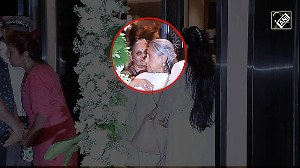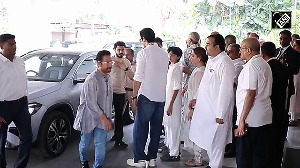There's a lot to be said in favour of technology, according to new-age photographers.
"If you disagree with digital photography, it means you haven't understood the technology. There's absolutely no difference in picture quality between conventional and digital cameras," says a Mumbai-based professional photographer.
Now that's not entirely true. The picture quality depends on the features and resolution of the camera you are using. Our photographer friend clearly comes from another plane. Digital cameras with lower resolution (like 2.0 megapixel) do not yield equally sharp, bright or vibrant pictures as conventional film cameras.
Today, there's a range of brands and cameras to chose from. All the brands -- Canon, Nikon, Sony, Olympus, Kodak, Samsung, Panasonic -- cater to the lower resolution (read cheaper) cameras with prices ranging from Rs 9,995 to Rs 25,000.
"These cameras are perfect for point-and-shoot situations, extremely user friendly and easy to carry," says Satish Bhatia of a multi-brand outlet -- Chandru Bros -- in Mumbai.
But if you are a serious, amateur photographer who's dabbled in photography with conventional single lens reflex (SLR) cameras, the lower resolution cameras will leave you frustrated.
Apart from the lower resolution, they are limited in features. Some may not offer manual controls or shutter speed and aperture controls. Not to mention the lag time (the time taken from when the shutter button is clicked to the picture being taken) that all digital cameras suffer from.
So if you're that much of a shutterbug, it's time you saved enough to become a prosumer -- a term coined by camera companies to describe serious, amateur photographers (also referred to as pro-amateur).
The range in this category includes digital SLRs which allow you to change lenses and have higher resolutions at above 6.0 megapixels.
They are the rage currently and offer varied image size options and features. "You should choose the camera based on what the end-use will be," says Sanjay Kothari of Photokina, a veteran camera dealer.
In the current scenario, professional photographers and dealers swear by the Canon EOS 20D and Nikon D70, both of which were introduced earlier this year. The models aren't strictly comparable.
The EOS 20D offers a 8.2 megapixel resolution against the Nikon D70's 6.1. Going by the megapixels, it would instead be fair to compare the Nikon with Canon's EOS 300D which has a resolution of 6.3 megapixel.
Even in terms of price, the EOS 300D at Rs 64,000 (dealer price) is closer to the Nikon D70 which is Rs 80,000, while the EOS 20D comes at Rs 1,17,500 for just the body.
Despite this, professional photographers place both cameras in the same league in terms of picture quality, sharpness and colour response.
The Canon EOS 20D clearly offers a better resolution as well as larger image size options at 3504 x 2336 compared to Nikon's 3008 x 2000, which means huge enlargements will be marginally sharper. The EOS 20D also has a noise reduction function for long exposure shots (pictures will be less grainy).
If you are shooting action, the Canon offers you a continuous 'burst' option of shooting five frames per second. And if you're sick of seeing the red-eye phenomenon in pictures taken with the flash, the Canon has a higher pop-up flash to reduce the problem.
However, user reviews on the Net point out that the flash synchronisation is slower at 1/250 of a second compared to 1/500 of a second for the Nikon.
The faster sync stops or captures motion better and allows greater control on the depth of field apart from giving the flashgun greater range.
The Nikon D70 was launched to beat Canon's EOS 300D in the prosumer category. It has excellent resolution compared to the EOS 300D and is neutrally colour balanced (colours appear more real). It also has negligible lag times.
In the end, it boils down to how serious you are about photography and how much moolah you have to burn. If you don't mind the slight resolution difference and are restricted by a budget, then the Nikon is your answer.
"It is a value-for-money camera with everything a pro-amateur would need," says a photographer. If there's nothing to hold you back, put the EOS 20D on top of your shopping list.








 © 2025
© 2025